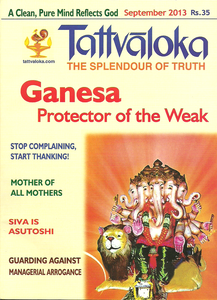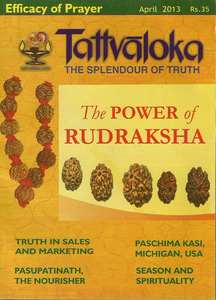1.4.7
The mantra has core teaching of Vedanta, namely, Brahman is satya, jagat is mithya, and jiva is not different from Brahman. Brahman is all-pervading pure existence. Pure existence is same as pure consciousness. Existence and consciousness are two aspects of Brahman. It is eternal and changeless. It has mAyA power which is a relative reality because it borrows existence from Brahman. MAyA is the aggregate of sanchit karmAs of all the jivAs at the end of one cycle of creation which rests in Brahman in unmanifest and potential form. At appropriate time, the world is projected due to mAyA power. The creation unfolds in stages starting from five elements in nascent forms. The undifferentiated Brahman appears as differentiated names and forms called world. At some stage, jivAs with gross and subtle bodies are created which are inert and they enclose the all-pervading consciousness. It is like a pot enclosing space. The enclosed consciousness is jivAtma. This phenomenon is figuratively described as entry of Brahman. It is like a waking man entering the dream. When the dream is over, the waking man says that he has experienced the dream. It means that the entity which experiences the waking state also experiences the dream.
Tag Archives: paramatma
Eight Upanishads (Topic-wise) Part 38
Chapter 7 Brahma Sutra Bhasya
7-4 BSB 3.2.22 to 3.2.30 Unconditioned Brahman and soul Neti neti means negation of two things and question is which are the two things negated. Purva Paksi argues that they are Brahman the substance and the attributes. According to Siddhanta negation of both leads to nihilism. Neti neti does not negate Brahman. It is negation of the attributes and not Brahman. Denial of Brahman is not reasonable, for that would contradict the introduction made with, “I will tell you of Brahman” (Br. 3.1.1), as also the condemnation contained in such texts as, “If anyone knows Brahman as non-existent, he himself becomes non-existent” (Tai. 2.6.1), and the affirmation, “The Self is to be realised as existing” (Ka. 2.3.13), “The knower of Brahman attains the highest”, “Brahman is Truth, Knowledge, Infinity” (Tai. 2.1.1). The text “Failing to reach which, words turn back with the mind” (Tai. 2.9.1) points to Brahman.
Tat Tvam Asi (Part 4)
Meaning of words, Direct meaning of a sentence, Bhag Tyag Lakshna, Suggestive meaning of a sentence
In chapter 3 of Naiskarmya Siddhi, SuresvarAchArya explains the method to interpret and operationalize Tat Tvam Asi. Like any sentence, TTA is made of words and to ascertain the meaning of a sentence, meaning of words is to be ascertained followed by their inter-se relationships. In Vakya Vritti (VV) 1.9 and 1.10, the teacher affirms the student’s concern that if he does not know the meanings of the words, how can he comprehend the mahAvAkya.
Eight Upanishads (Topic-wise) Part 19
Chapter 6 JnAna and Moksha
6-5 Katha Upanishad
6-5-9 Katha 1.2.25 The mantra reads: How can one know thus as to where It (the Self) is, for which both the Brahmin and the Kshatriya become food, and for which death takes the place of a curry? Brahma Sutra 1.2.9 clarifies who is the eater. Is it fire or the individual soul, or is it the supreme Self? The doubt is because Nachiketa has asked Yama about three entities-fire, individual soul, and the supreme Self.
Eight Upanishads (Topic-wise) Part 17
Chapter 6 JnAna and Moksha
6-4 Kaivalya Upanishad
6-4-1 Kaivalya 8 to 10
Brahman is the only reality. The empirical world has borrowed existence. Brahma, Vishnu, Siva, and Indra are manifestations of Brahman. The empirical world beginning with time and unfolding of vital forces and fire are manifestations of Brahman. By knowing that Brahman as Self, one conquers the tyranny of death that batters everyone. By Self-knowledge only, one can cross the scourge of time. There is no method other than this. Karma Yoga, UpAsanA Yoga and Bhakti Yoga are supportive disciplines for purifying the mind for gaining knowledge.
upadesha sAhasrI – Part 22
 Part 22 of the serialization of the presentation (compiled by R. B. Athreya from the lectures given by Swami Paramarthananda) of upadesha sAhasrI. This is the prakaraNa grantha which is agreed by most experts to have been written by Shankara himself and is an elaborate unfoldment of the essence of Advaita. Note that this is the concluding part of the series.
Part 22 of the serialization of the presentation (compiled by R. B. Athreya from the lectures given by Swami Paramarthananda) of upadesha sAhasrI. This is the prakaraNa grantha which is agreed by most experts to have been written by Shankara himself and is an elaborate unfoldment of the essence of Advaita. Note that this is the concluding part of the series.
Subscribers to Advaita Vision are also offered special rates on the journal and on books published by Tattvaloka. See the full introduction
upadeSha sAhasrI – part 17
Part 17 of the serialization of the presentation (compiled by R. B. Athreya from the lectures given by Swami Paramarthananda) of upadesha sAhasrI. This is the prakaraNa grantha which is agreed by most experts to have been written by Shankara himself and is an elaborate unfoldment of the essence of Advaita.
Subscribers to Advaita Vision are also offered special rates on the journal and on books published by Tattvaloka. See the full introduction

